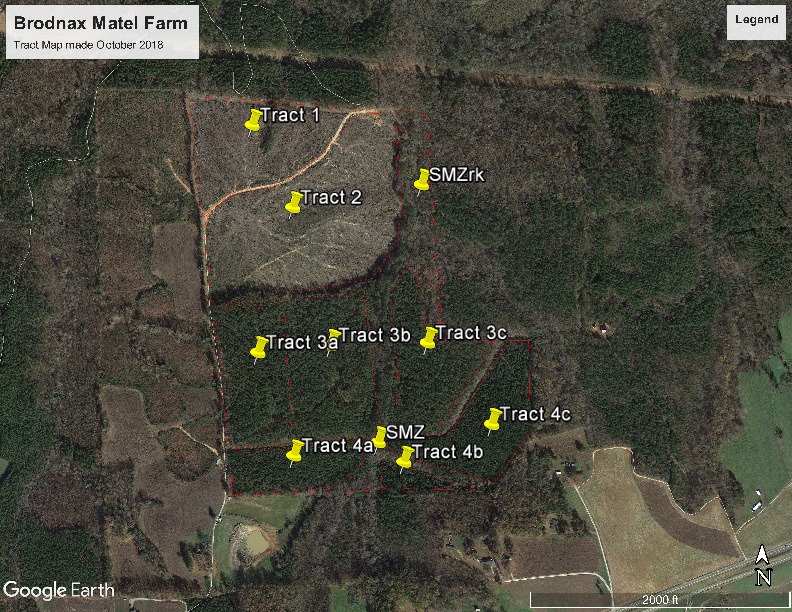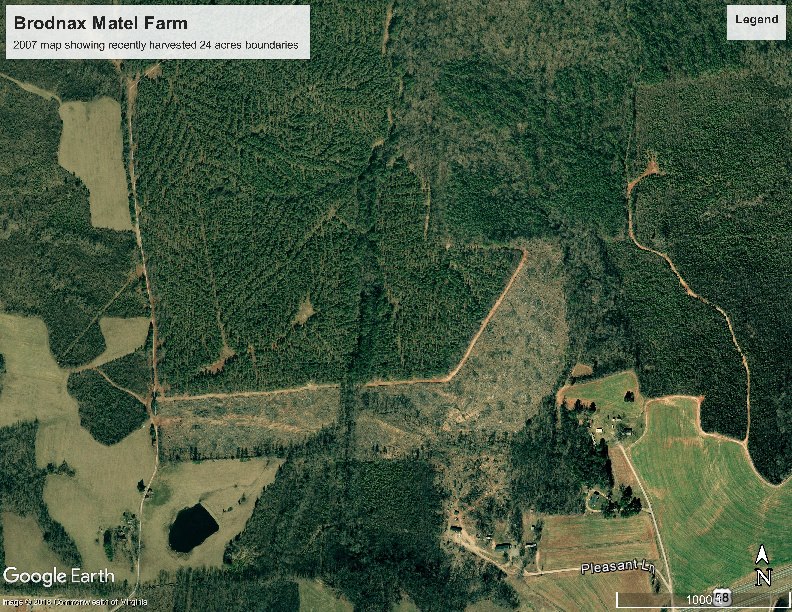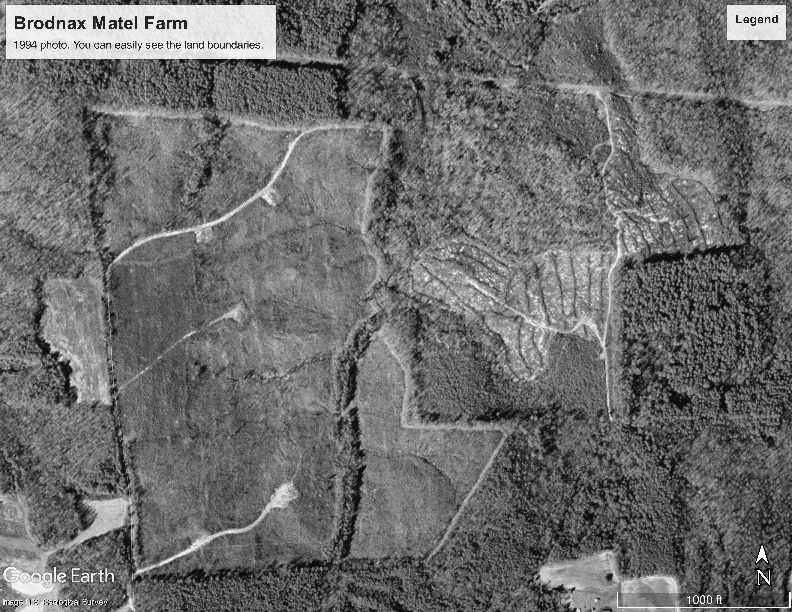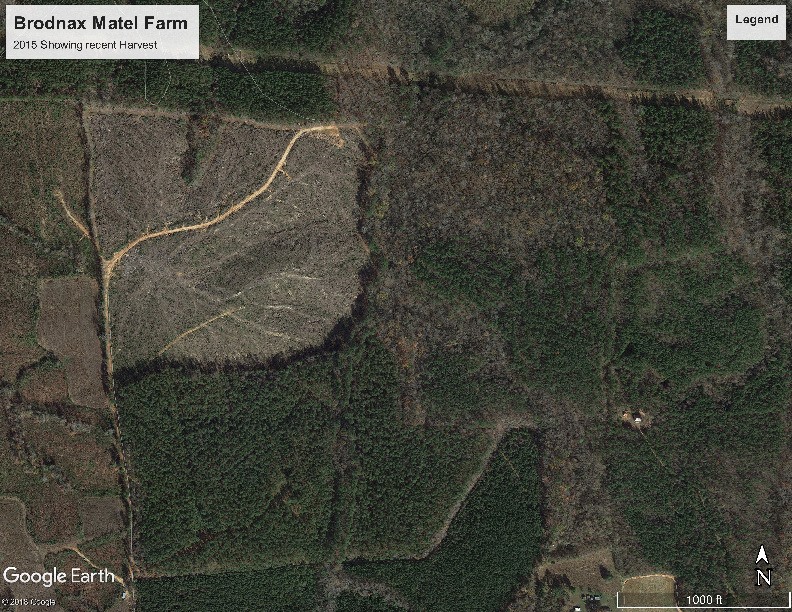Keeping up with our plans for our forests.
Tract 1
Acres: 20
Forest Type: Longleaf pine
Species Present: Loblolly & longleaf pine, ailanthus, American sycamore, sweet gum, yellow poplar, eastern red cedar, hackberry, shortleaf pine, Virginia pine, mockernut hickory, white oak, chestnut oak, black oak, green ash, mulberry, sassafras, black cherry, persimmon, holly, black locust, blackgum, and red maple.
Age: Longleaf pine planted 2016. Volunteers of other species same time.
Size: Planted 2016. Currently small
Quality: good. IMO a little thin with longleaf.
Trees/acre: Thinly stocked for our management objectives, but enough, since we want to allow growth of grass and forbs.
Growth Rate: excellent.
Recommendations:
The vegetative nature of this parcel provides benefits to wildlife due to the diversity of ground covers and understories. We plan to:
- Do understory burns every 2-4 years. This will over time make the stand more exclusively longleaf
- Create field borders on this parcel
- Maintain and enhance diverse and native ground covers
2019 observations and actions
Tract became overgrown with brambles and hardwood brush, a lot of redbud very aggressive. I made paths with my cutter and looked for longleaf. I found that the site is insufficiently stocked with longleaf. My guess is that it results from too low survival rate after planting and competition, even though we did release spray and burning in fall of 2017. The task of trimming around the extant longleaf is labor intensive, but I had the tool and time, so I did it. It is, however, clear that even if all the longleaf survive, there will never be enough of them to dominate the site.
My new plan is to diversify the tracts with oak and super loblolly. The oaks will be a mix between natural regeneration and an experiment with 150 acorns I gathered under a magnificent bur oak near the Capitol. I have cleared brush and planted the acorns. See if they grow. I am also letting the nearby oaks seed in. I have ordered a thousand “super” loblolly and I will put them in the rows where longleaf woulda/shoulda been. I figure that the longleaf head start will make them about the same size at first thinning.
Tract 2
Acres: 30
Forest Type: Loblolly pine planted 2016
Species Present: Longleaf & loblolly pine, sumac, some oak, ailanthus, American sycamore, sweet gum, yellow poplar, eastern red cedar, hackberry, shortleaf pine, Virginia pine, mockernut hickory, white oak, chestnut oak, black oak, green ash, mulberry, sassafras, black cherry, persimmon, holly, black locust, black gum, and red maple.
Age: Planted in 2016
Size: Tallest around 8 feet high in 2018
Quality: Excellent
Trees/acre: Adequately stocked. Trees are widely spaced on purpose to allow wildlife and understory growth
Growth Rate: Excellent
Recommendations:
Parcel will be burned o/a 2021, a cool season fire to clear hardwood and thin volunteer loblolly. Density will be maintained low enough to allow growth of forbs and grass for wildlife habitat.
2019 observations and actions
The trees are doing very well on most of the tract. In some places, however, they are overgrown with hardwood competition, especially gum, poplar and redbud. The redbud is a surprising competitor. I just never thought about it, but it has formed tight thickets that are shading out everything else. I have been doing “touchup” with my cutter, knocking down the thickets. I figure this will give the loblolly the advantage they need to get above the redbud, which can then form the pleasant understory.
Tract 3 a, b & c
Acres: 45
Forest Type: Loblolly & longleaf pine.
Species Present: Loblolly and longleaf pine, ailanthus, American sycamore, sweet gum, yellow poplar, eastern red cedar, hackberry, shortleaf pine, Virginia pine, mockernut hickory, white oak, chestnut oak, black oak, green ash, mulberry, sassafras, black cherry, persimmon, holly, black locust, blackgum, and red maple.
Age: Loblolly planted 1992. Longleaf pine planted 2018/19
Size: chip and saw to sawtimber, loblolly; longleaf are seedlings
Quality: excellent
Trees/acre: Adequately stocked, although purposely thinner than standard management due to our desire to maintain wildlife habitat.
Growth Rate: Excellent
Recommendations:
Tract a, b & c will be burned in alternatively to create and maintain wildlife habitat and maintain a fire regime more like pre-settlement patterns in Virginia. This tract also includes pollinator habitat planted in 2018 along the edges. We hope and expect this to seed into the sunny forest.
2019 observations & actions
The growing season fire of May 2018 on tract 3a killed about two dozen trees. I left them as snags for wildlife and planted some longleaf underneath. I have also been in with my cutter, knocking down hardwood except for oak. The fire did a good job of cleaning up the understory.
The dormant season fire on February 2019 on 3c was nearly perfect. I have some oak regeneration in the understory and will be on the look out to protect them, but I have done nothing besides observe.
Mixed results with pollinator habitat. We planted around five acres along the edges in 2018. Some came back in 2019, but not as profusely as I would like. I will plant in some patches in spring 2020
Tract 4 a, b & c
Acres: 24
Forest Type: Loblolly pine.
Species Present: Loblolly and longleaf pine, ailanthus, American sycamore, sweet gum, yellow poplar, eastern red cedar, hackberry, shortleaf pine, Virginia pine, mockernut hickory, white oak, chestnut oak, black oak, green ash, mulberry, sassafras, black cherry, persimmon, holly, black locust, blackgum, and red maple.
Age: Loblolly planted 2007
Size: mostly pulp; some chip and saw
Quality: excellent
Trees/acre: Adequately stocked, maybe even a bit too tight. Shade does not allow much to grow on the ground under the trees.
Growth Rate: Excellent
Recommendations:
Tract a, & c will be burned in alternatively to thin in lieu of pre-commercial thinning. Track 4b will be left unburned as a control plot
2019 observations and actions
I walked around the tract but saw nothing useful to do. There are some vines growing into the trees and if I have extra time (unlikely) I can do in and knock some of them down, but the site is well stocked, and the canopy has closed. Wait for first thinning.
PARCEL SMZ
Acres: 18
Forest Type: Mixed hardwoods and pine.
Species Present: Loblolly pine, ailanthus, American beech, American sycamore, sweet gum, yellow poplar, eastern red cedar, hackberry, shortleaf pine, Virginia pine, mockernut hickory, white oak, chestnut oak, black oak, green ash, mulberry, sassafras, black cherry, persimmon, holly, black locust, blackgum, and red maple.
Age: 40 to 80+ years
Size: Various sizes including significant saw timber. (10 to 18 inches in diameter)
Quality: Good to excellent
Trees/acre: Adequately stocked
Growth Rate: Good to excellent
Recommendations:
This parcel is in place to protect water quality and to provide wildlife corridors. We will periodically examine the SMZs for invasive species and treat as appropriate. Beyond that, this area will be generally left to natural processes, with interventions only in the case of some sort of disaster, such as fire or particularly violent storms.
2019 observations and actions
I walked through the stands several times. The forests look healthy. Our February 2019 dormant season prescribed fire backed down through the adjacent SMZ, cleaning up some of the brush and litter and resulting in a little “thinning from below.” We plan to back fire down the other side of the SMZ in winter of 2020. Periodic burns should have beneficial effects over time.
Prepared by: _John Matel____________________________
Timeline
Year Tract Activity
2018
—3a Growing season burn – Done
–3a Understory plant longleaf – Done
2019
–3c dormant season burn – Done
2020
–3b & 4a Winter burn
2021 or 2022 depending on conditions
–1 & 2 Winter burn, maybe whole property
2022
–SMZ Remove invasive species
2023
–3b & c Clear cut harvest
–3a Harvest leaving 8 seed trees per acre
–4a, b & c First thinning to 80 BA
–3 & 4 Spray
2024
–3b & c Plant with Longleaf pine 400/acre
–3a Seed tree regeneration
2025
–1 Winter burn
2028
–1 & 3b & c Winter burn
2030
–4a, b & c Thinning to 50 BA
–3a Harvest seed trees
–1, 2, 3b & c Winter burn
This schedule may need to be adjusted depending on financial needs, timber markets, timing of actual harvest, and availability of contractors.




